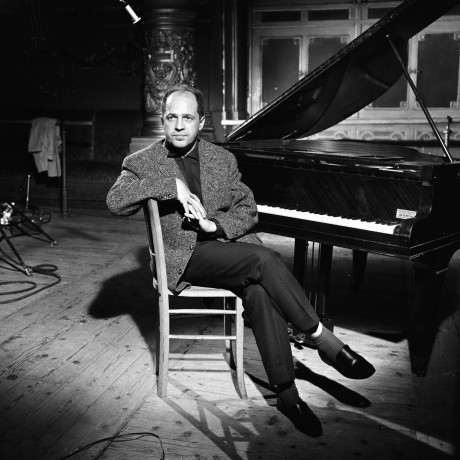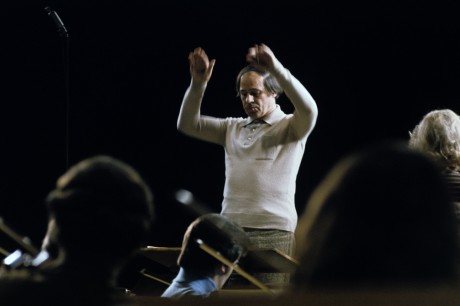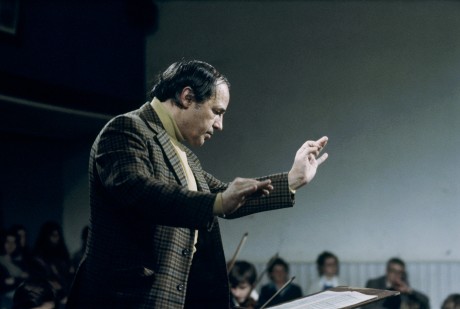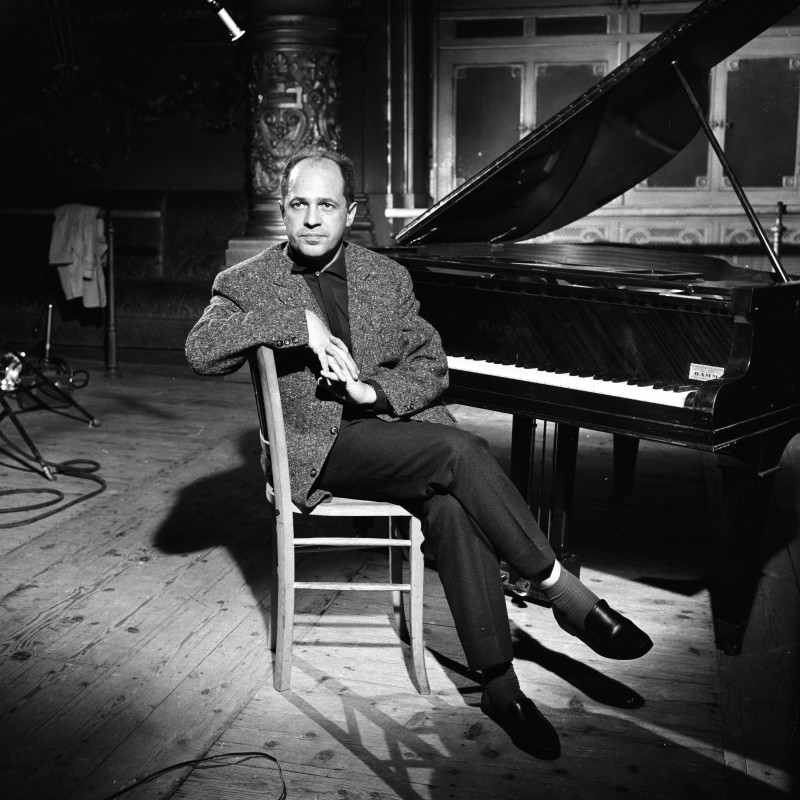Biography
The road to music
Pierre Boulez was born on March 26, 1925 in Montbrison, near Lyon. His father, an engineer, wanted him to follow his steps so he studied Advanced Mathematics at the Lyon University with only 17 years. However he was determined to pursue a career in music and in 1943, with the support of his sister Jeanne, persuaded his father to let him go to Paris where he started his musical studies at the Conservatory and privately with different teachers in order to consolidate his musical knowledge. In 1944 he joined the Olivier Messiaen advanced harmony class private seminars on twentieth century music analysis, where only selected students would assist.
In order to deepen on twelve-tone technique, he started studying in 1945 with René Leibowitz, a follower of Schoenberg. He also discovered with fascination the music of Webern as well as Japanese, African and Balinese music at the Guimet Museum in Paris, which strongly opened his horizons. He also started composing his first works as the Piano Sonata (1946) and working as a musician to earn a living.
Becoming a musician
Living in after-war Paris was not an easy issue; he gave mathematic lessons and played the Ondes Martenot with the Folies Bergère’s orchestra. The encounter with Jean-Louis Barrault in 1946 opened a long period of collaboration with this famous director and actor who owned the theatre company Renaud-Barrault; where he played the Ondes Martenot and quickly became Music Director of the Company.
In 1954 he started a concert series which became know as the Domaine Musical; where he presented works by his contemporary colleagues and works of the first half of the 20th century. There he proved he was an accomplished administrator being in charge of all aspects of the organization including accommodation for the musicians and searching for patrons to finance his series. Young people and artists attended the concerts where new works were premiered and festivals dedicated to composers like Webern organised. The company was under his direction until 1967 and finally dissolved in 1973.
It is at the Domaine Musical that Pierre Boulez started his career as a conductor in 1956 where he directed his first full concert with his Le marteau sans maître. He also started performing his piano works; the first performance of Structures 1a for two pianos was done together with Olivier Messiaen in 1952!
What strikes about Boulez is that since his earliest years he was an active and restless intellectual, with a harsh and pugnacious character that softened down with time. He had a strong consciousness of his position in society and tried through all his life to change structures and innovate in the way music was conducted and composed, and how the public received it. He invented structures and institutions with the permanent objective to enhance and pursue the renew of music.
The composer and conductor
Boulez started composing when he was at school. His first acknowledged work is the Sonatine pour flûte et piano composed between 1946 and 1949. We can see here one of his trends to work over long periods or to review earlier works, which he clearly assesses when he says:
“…as long as my ideas have not exhausted every possibility of proliferation they stay in my mind."
[Paul Griffiths, Boulez, London 1978]
His work Notations for chamber orchestra was composed in 1946 after a first version for piano in 1945; he orchestrated the work in the seventies and it was first performed only in 1980.
Between 1945 and 1960 he composed almost half of his repertoire, with marking works like Le marteau sans maître (1953–55) based on a text by René Char or Pli selon pli (1957–62) carrying the subtitle of Portrait de Mallarmé, the famous French poet; here Boulez shows his strong relation to poets and poetry. He withdrew many of his early works or the ones he considered less important regarding his musical ideas. However radical he was regarding the musical world and his opinion about composers (he totally refused to conduct Tchaikovsky); he expressed himself much less regarding his own music.
After starting conducting during the Domaine Musical period, he developed his skills and brought into conduction his strong personality and his quest for perfection. He started to conduct the most renowned orchestras of the world: Amsterdam’s Concertgebouw, Bavarian Radio Symphony, Südwestfunk orchestra, Berlin Philharmonic orchestra, Orchestre National de France, presenting major Twentieth Century works and continued his career as conductor all through his life.
During the sixties and the seventies, he developed his conductor career with the BBC Symphony Orchestra and the New York Philharmonic, thus reducing his activity as a composer. However he composed Book 2 of his Structures for two pianos in 1961 or Éclats/Multiples for small ensemble in 1970. The composition periods for some works span over several years due on one-side to his seek of perfection and on the other to his numerous responsibilities and travels.
Creating institutions
Pierre Boulez had a high interest in technology and how they could bring a new dimension to musical thought and practice. He was convinced that new structures and institutions were needed through which music could advance and new ideas could be developer in the domains of musical creation, performance and halls for musical listening.
In 1975 he started working again in France and created with the support of the French government a Centre in Paris for musical research in technology, composition and performance with the name of IRCAM, with the ambition to provide composers a place to work on new forms and trends in music. He also developed a unique ensemble of musical virtuosos, the Ensemble Inter Contemporain (EIC) which he formed and conducted regularly; to give composers and the contemporary repertoire high level musical performances.
His last achievement was the impulse he gave to build the Cité de la Musique in 1995, a place dedicated to music with two wonderful concert halls which become the Paris Philharmonie in 2016 and whose main hall is dedicated to him.
Last years, the great conductor
In IRCAM he could concentrate in exploring and experimenting the relation between instruments and technology now disposing of computer technology. He composed four major works during this period; Répons (1980-84) a 45’ long work for 6 soloists and computer electronics; Dialogue de l’ombre double (1982-85) for clarinet and computer electronics; …explosante-fixe…, for MIDI-flute, chamber orchestra and computer electronics, of which four versions exist, the first one from 1972 and the fourth one over the period 1991–93; Anthèmes 2 (1998) for violin and computer electronics. All four works explore the relations between the sound of the instruments, their transformation and the use of space as a musical parameter for sounds to move.
In 1992 Pierre Boulez gave up directing Ircam and went back to composing and conducting. He continued his conducting career that took him to the most important orchestras in the world and often the EIC following him in his tours. He continued conducting symphonic music while enlarging his musical interests to musical works other than 20th or 21st century. He continued directing opera, mainly 20th century ones, including a new version of the Ring. In 2004 he co-founded the Lucerne Festival Academy, a summer campus dedicated to young musicians where 20th-century and contemporary works are studied and performed in concerts. For the following ten years, he would assist for three weeks every end of August to the Festival, to work with young musicians and open their ears and minds to the performance of contemporary music.
He composed a few works over this last period, mainly re-working existing works and often planning new sections for them. There was talk about an opera…, which never arrived. He conducted until 2012; he had started having eye problems and his health started failing until his death in January 5, 2016 in Baden-Baden, city in which he had lived since 1961.
His place in music
Pierre Boulez belongs to an extraordinary generation of composers born between the two world wars that emerged after second world-war: Bruno Maderna, Luciano Berio, John Cage, Luigi Nono, Karlheinz Stockhausen were his colleagues and friends, he conducted them regularly and exchanged views on music and musical practice. He was also a great writer on musical ideas and how music should develop; in his young years he was quite radical, with very strong affirmations in defence of twelve-tone music and the fact that he considered that
“any musician who has not experienced—I do not say understood, but truly experienced—the necessity of dodecaphonic music is USELESS. For his whole work is irrelevant to the needs of his epoch."
[Pierre Boulez, Stocktakings from an Apprenticeship, New York 1991]
He softened his position through time and even recognised he had often had a “bullying” attitude towards other people and mainly institutions but he insisted on the fact that there was a strong need to fight against established ways of making music.
His musical work has had a strong influence on young generations. He started with dodecaphonism and integral serialism, as a need to break with the main ideas music had dealt with over the last three centuries; he worked with controlled chance as a way to organize the composer’s material in different and open structures. He then softened his need for serialism and composed two of his strongest and more influencing works over time: Le marteau sans maître (1952), and Pli selon pli (1957–89). His “work in progress” style is characteristic of his continuous search for perfection, which appears all over his work, be it composition, conducting and writing. During the seventies, his works become more clear and intricate, working more on the global perception while maintaining a strong set of musical ideas to develop. The works of the Ircam period and the last years are those more frequently performed.
He received throughout his life many international honours and prizes, like the Kyoto Prize in 2009 or the Spanish BBVA Foundation Award in 2013. He was celebrated everywhere and his years anniversaries had international repercussion; his 70th and 80th anniversaries have been wonderful moments for a retrospective of his career and works.
When he died all over the world newspapers and musicians celebrated the importance of Pierre Boulez in music, through his compositions and unique conducting style. François Hollande said:
He never ceased to think about subjects in relation to one another; he made painting, poetry, architecture, cinema and music communicate with each other, always in the service of a more humane society.
He struggled all his life for a new and contemporary musical world opening roads to young generations and to the love of music.






